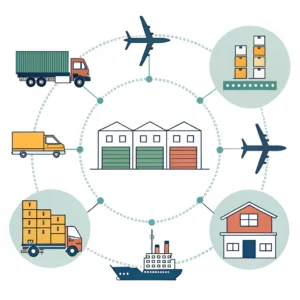A quick answer: To ship from China to the USA by sea, you need to choose the right container type (FCL or LCL), prepare all required documentation including customs clearance, and work with a reputable freight forwarder to manage consolidation, port handling, and inland trucking. This guide walks you through the entire process to ensure cost‑effective and reliable ocean shipping.
Shipping goods from China to the USA by sea is a popular choice for businesses seeking a cost‑effective and scalable solution for transporting large volumes of cargo. In this article, we break down the entire process from container selection to customs clearance, providing actionable insights and practical examples for logistics managers and business owners involved in international freight forwarding1.
Shipping by sea requires careful planning and coordination. When transporting goods via ocean freight, you have to consider multiple factors—from choosing between full container load (FCL)2 and less-than-container load (LCL) options, to ensuring that the necessary documentation and customs procedures are followed meticulously.
-
Container Selection:
- FCL (Full Container Load): This option is ideal when you have enough goods to fill an entire container. It offers better protection for your cargo and can be more cost‑effective per unit.
- LCL (Less-Than-Container Load): When your shipment does not fill a container, LCL allows you to share container space with other shipments. Although economical for smaller loads, LCL might lead to longer transit times.
-
Documentation:
- A Bill of Lading3, commercial invoice, packing list, certificate of origin, and other regulatory documents are essential. Proper documentation ensures that your shipment complies with regulations and clears customs smoothly.
-
Customs Procedures:
- Customs Clearance: Efficient customs clearance is vital to avoid delays. Hiring a professional customs brokerage4 service can help manage paperwork and reduce the chances of hold-ups at the US ports.
-
Port Operations:
- Major ports in China such as Shanghai, Shenzhen, and Ningbo offer a range of services including container handling and consolidation. On the US side, ports like Los Angeles, Long Beach, and New York/New Jersey ensure efficient unloading and inland trucking.
-
Consolidation Services:
- For LCL shipments, consolidation services combine several small shipments into one container, reducing costs while maintaining safety protocols for each individual shipment.
Before you even contact a freight forwarder, it is crucial to understand your shipping needs. The following checklist can help you get started:
- Determine Cargo Volume: Calculate whether you need FCL or LCL.
- Identify Cargo Type: Different goods have different handling requirements and regulatory needs.
- Set a Budget: Understand your cost constraints, which include port fees, fuel surcharges, and insurance.
- Timeline: Decide your required transit time. Ocean shipping is generally slower than air freight, but offers significant cost savings.
Create a project plan that details the logistics timeline, points of responsibility, and contingencies. This preparatory work is essential to avoid costly delays.
A reliable freight forwarder like Shenzhen King-Hor Supply Chain Co.,Ltd can guide you through the entire shipping process. Their expertise covers:
- Documentation and Compliance: Ensuring all paperwork complies with both Chinese export and US import regulations.
- Consolidation Management: Arranging LCL consolidation if your shipment volume does not justify an entire container.
- Coordination with Ports: Assisting with port operations and handling procedures to minimize delays.
- Cost Management: Advising on cost‑effective options based on your volume and shipment urgency.
By partnering with a freight forwarder, you tap into specialized knowledge and a network that spans the entire global supply chain5.
Choosing the right container type can significantly affect the overall cost and transit time of your sea freight. The table below summarizes key differences between FCL and LCL shipping:
| Container Option | Volume Capacity | Cost Efficiency | Transit Time | Best For |
|---|---|---|---|---|
| FCL (Full Container Load) | Full container (20-ft or 40-ft) | Lower cost per unit volume | Standard | Large shipments, dedicated cargo |
| LCL (Less-Than-Container Load) | Partial container load | Cost-effective for small loads | May be extended | Small shipments, consolidation |
When budgeting, remember that a 20-ft container from China to the USA typically costs between $2,000 and $3,500. Although prices fluctuate, understanding this range can help you negotiate better terms with your provider.
One of the most complex aspects of ocean shipping is navigating customs clearance. Here’s how you can streamline this process:
- Accurate Documentation: Inaccurate or incomplete documentation is one of the leading causes of shipping delays. Ensure that each document (Bill of Lading, commercial invoice, packing list) is correct.
- Customs Brokerage Services: Working with an experienced customs broker, such as those provided by King-Hor Supply Chain, can help prevent unnecessary delays. They verify that your shipment meets all regulatory demands.
- Regulatory Compliance: Stay updated on both Chinese export regulations and US import laws. Compliance ensures a smooth cross-border transfer and reduces the risk of fines or confiscation.
It is also beneficial to have contingency planning for unexpected issues at the ports. Build close communication with your broker to swiftly resolve any complications.
In today’s digital age, real-time tracking and communication are pivotal aspects of successful sea shipping. Advanced tracking systems allow you to monitor shipment progress from the port of departure in China until the cargo reaches its final destination in the USA. Here’s what to look for in a good tracking system:
- Real-Time Updates: Ensure that your service provider offers real-time data on your cargo's location and status.
- Alerts and Notifications: Automatic alerts for delays or issues can help you take proactive measures.
- Detailed Reporting: Access to detailed documentation and tracking reports helps in audit and performance evaluation.
Efficient tracking builds trust among stakeholders and enables quick decision-making when changes in the plan are required.
Shipping by sea is inherently more economical than air, but there are several strategies that can further reduce costs:
- Maximize Container Use: If opting for LCL, try to consolidate shipments to reduce per-unit cost.
- Negotiate Rates: Freight forwarders often have established relationships with port authorities and shipping lines. Leverage these relationships to negotiate better rates.
- Plan Ahead: Last-minute shipments might incur additional fees. Forecast your needs to plan shipments well in advance.
- Consider Transit Times: Sometimes a slightly longer transit time offers significant cost benefits. Align your shipping schedule with business requisites for optimal balance.
Implementing these tactics can significantly influence your overall logistics cost and improve profit margins.
Consider a medium-sized electronics exporter in Shenzhen who frequently ships products to the USA. By assessing their quarterly volumes, they utilize FCL shipments for high-demand periods while opting for LCL during off-peak times. Their chosen freight forwarder assists in handling the intricate details of customs brokerage, documentation, and inland trucking. As a result, they maintain a consistent delivery schedule with minimized delays and controlled costs.
Data from industry reports indicate that businesses using a mix of FCL and LCL based on shipment size achieve up to 15% cost savings compared to rigid shipping schedules. This flexibility is vital in balancing demand fluctuations and supply chain uncertainties.
To sum up, successful sea freight shipping from China to the USA revolves around these core elements:
- Preparation: Understand shipping volume, document requirements, and regulatory checkpoints.
- Partner Selection: Choose a reputable freight forwarder with comprehensive services like customs brokerage and inland trucking.
- Container Choice: Evaluate the benefits of both FCL and LCL in terms of cost, efficiency, and risk.
- Documentation and Customs: Ensure all paperwork is meticulously completed and compliant with international trade regulations.
- Continuous Improvement: Leverage tracking technology and partner feedback to refine logistics processes over time.
By following this structured approach, you can not only reduce risks and delays but also achieve significant cost savings in your ocean freight operations. Integrating these practices into your global supply chain management efforts will enhance overall operational efficiency and service timeliness.
For additional information on optimizing your ocean freight shipping, feel free to dive into more detailed guides or consult with logistics experts familiar with the dynamic markets between China and the USA.
Q: How much is sea shipping from China to USA?
A: Sea freight for a 20‑ft container from China to the USA typically costs between $2,000 and $3,500. The final price depends on several factors such as fuel surcharges, port fees, and the specific type of goods being shipped.
Q: What is the sea route from China to USA?
A: There are generally two sea routes. The direct route crosses the Pacific Ocean to the Western Coast, while the indirect route involves navigating the South China Sea, crossing the Indian Ocean, passing through the Middle East via the Suez Canal into the Mediterranean, and continuing to the Eastern Coast of the USA through the Atlantic Ocean.
-
International Freight Forwarding: Read this article to understand the comprehensive process of coordinating and managing shipments across international borders, covering logistics, regulations, and documentation steps. ↩
-
Full Container Load (FCL): Click here for insights on the advantages of utilizing an entire container for shipments, including cost efficiency, security, and logistic coordination. ↩
-
Bill of Lading: Explore this essential shipping document that outlines the contract between the shipper and carrier, detailing the nature, quantity, and destination of the goods. ↩
-
Customs Brokerage: Discover how professional customs brokerage services streamline the complex customs clearance process, ensuring your shipments comply with import/export regulations. ↩
-
Global Supply Chain: Learn about the elements and dynamics of a global supply chain, including the integration of suppliers, manufacturers, and logistics providers for seamless operations. ↩












